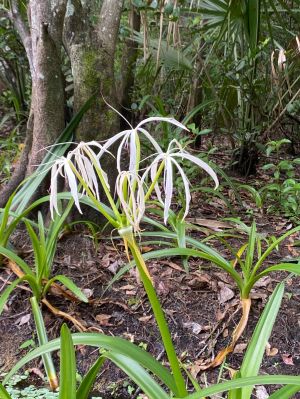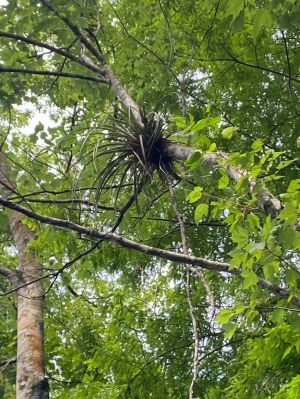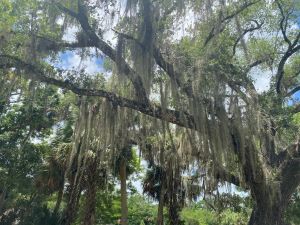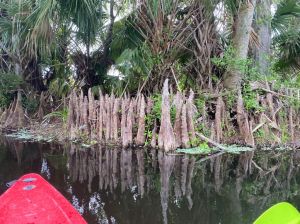LOXAHATCHEE KAYAKING – MYTHS & FACTS ON RIVER PLANT LIFE
6/2/2022
Loxahatchee Kayaking
Tall tales, legends, rumors, facts — the mysterious and colorful plants along the Wild & Scenic Loxahatchee River have a rich history.
Sweet-smelling swamp lillies, stumpy cypress knees, fluttery Spanish moss, mysterious air plants and bluish spots on trees — not only are they beautiful, but they have stories to tell.
SWAMP LILY

(Photos/Video: Bill DiPaolo)
In Greek mythology, the lily was the flower of Hera, wife of Zeus. Legends the lily was formed from the milk of her breast. In Roman mythology, Venus, the Goddess of beauty was so jealous of the flower’s white loveliness that she caused the pistil to grow from its center.
Sweet smelling and elegant, swamp lilies look like starbursts along the banks of the Lox.
Native to Florida, the plants grow up to three feet tall. They love the full sun and thrive in wet soil.
While smelling and looking good is fine, it has its downside.
Insects like grasshoppers and flies love to snack on swamp lillies.
Take your time checking out these plants on your Loxahatchee adventure.
Sign up for a Loxahatchee Kayaking tour here.
AIR PLANT

Air plants are nature’s hitch hikers, hooking on to other plants for a ride.
And they actually are pretty good guests.
After all, they don’t ask their host for much.
They don’t require soil to grow. They don’t damage they plants they hitch a ride on. They don’t require food from their host. Air plants feed themselves by collecting moisture and food fibers from the air.
Home gardeners are catching on, as air plants are growing in popularity. There’s hundreds of species of air plants. Some have colorful flowers.
Air plants are not parasites, unlike the strangling fig tree.
Look up on your Loxahatchee Kayaking tour as you paddle under a towering cypress tree. Air plants are in the branches, they look like a tuft of grass.
Sign up for a Loxahatchee River tour here.
SPANISH MOSS

First of all, Spanish moss is not Spanish. It’s native to North America, growing as far north as Virginia. And it’s not moss. It’s a bromeliad, related to the pineapple plant.
Early settlers braided the moss into ropes and netting. They used it to stuff cushions. Visitors brought it back up north as souvenirs. They put it on their trees as a reminder of their Florida visit.
Clumps of Spanish moss are hotels for biodiversity. You’ll see the spooky stuff on your Loxahatchee Kayaking tour or if you take a paddling tour to Fullerton Island.
Insects, bats, frogs, lizards, snakes and more live inside the stuff.
Birds like yellow-throated warblers and northern parulas make their nests during the spring and summer.
And there is one species of spider that can only be found living in Spanish moss.
Sign up for a guided tour of Fullerton Island here.
CYPRESS KNEES

Cypress knees — scientists are stumped.
Spiking out around the base of the flood-tolerant trees, the knobby nubs form cypress domes up to six feet high around the tree. The area surrounded by the knees is known as cypress savannas, sawgrass marshes where more cypress trees sprout.
Some scientists conclude the knees serve as anchors to keep the tree in place. After all, take a look around on your Loxahatchee Kayaking paddle adventure. Many cypress trees 60 feet high and higher.
Nope, say other scientists. Collecting oxygen is the reason the the knees.
Nah, scoff more scientists. The knees defend the trees growing in the most soil against predators.
What do you think?
Sign up for a Pedal & Paddle tour here.
POND APPLES

Don’t Eat ‘Em!
About the size of tennis balls, these green apples grow on trees that you see on your Loxahatchee Kayaking adventure.
The yellowish/orange inside has a sweet aroma. The pulp is fleshy, mealy, and pithy. The flesh is filled with more than 100 dark-colored seeds within. The seeds are poisonous. Powder from the seeds have been known to blind people.
Although sometimes called alligator apple, they are also eaten by turtles, birds, raccoons and squirrels.
Sign up for a Mangrove Mystery Tour here.
Did You Know:
* The Loxahatchee River is one of Florida’s two nationally designated Wild and Scenic Rivers. The other the Wekiva River in Central Florida.
* The “wild and scenic” part of the Loxahatchee River is the 7.6-mile stretch from Riverbend Park in Jupiter downstream to Jonathan Dickinson State Park.
* Loxahatchee is a a Seminole Indian word meaning “River of Turtles.”
* Fullerton Island was proposed to be a private island with mansions. Instead, the town of Jupiter bought it in 2008 for $2.9 million. The town and county spent $3 million dredging, removing exotic plants, building docks and planting mangroves and other native plants.

